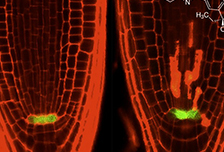Plant-derived anti-cancer drug targets stem cells
NUS biologists have discovered that campotothecin (CPT), a highly selective DNA topoisomerase 1 (TOP1) inhibitor, targets stem cells in the root of the non-CPT-producing weed Arabidopsis thaliana.
Plants produce a variety of toxic compounds, many of which exhibit potent anti-cancer activity. CPT was originally extracted from the Chinese tree Camptotheca acuminate (or “Happy tree”, which is a direct translation of the Chinese name xǐ shù), which was discovered in 1966 in a systematic screening of natural products for anticancer drugs. Currently, two CPT analogues, topotecan and irinotecan, have been approved and are used in cancer chemotherapy. However, the mechanism of action of CPT in vivo remains unclear.
A research team led by Prof Jian XU from the Department of Biological Sciences and the Centre for BioImaging Sciences at NUS has discovered for the first time that CPT targets stem cells in the root of the non-CPT-producing weed Arabidopsis thaliana. They have established the use of the Arabidopsis root as an in vivo system tostudy the interaction of plant-derived anti-cancer drugs with stem cells and their niche environment. They show that CPT specifically disrupts the in vivo function of TOP1α, one of the two homologues of human TOP1 in Arabidopsis, leading to either death or differentiation of root stem cells. Interestingly, the same compensatory mutation found in CPT-producing plants and CPT-resistant human cancer cells also contributes to CPT resistance in the Arabidopsis root, suggesting that the CPT-interacting residues in TOP1 are conserved across plant and animal kingdoms.
This study provides proof-of-principle evidence that an inplanta system can be used to screen and identify anti-cancer drugs targeting stem cells. Using the same system, the research team is currently working to formulate novel combinatorial chemotherapeutic regimens that effectively prevent cancer stem cells-mediated drug resistance and tumour recurrence.

Figure shows root tips of wild-type Arabidopsis seedlings treated with mock (left) and CPT (right) for 24 hours. Root cells were counterstained with propidium iodide, which was excluded from entering live cells but penetrated into dead cells. Cells stained with green fluorescence are surrounded by root stem cells.
Reference
Zhang, YH, Zheng, LL, Hong, JH, Gong, XM, Zhou, C, Pérez-Pérez, JM and Xu, J. “TOPOISOMERASE1α acts through two distinct mechanisms to regulate stele and columella stem cell maintenance.” Plant Physiology. 171 (2016) 483-493.
